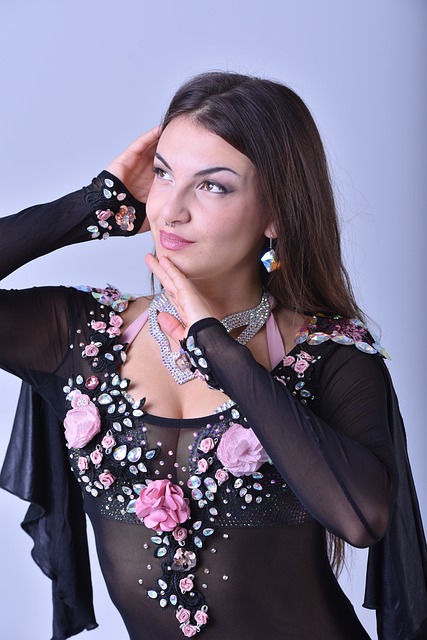In the realm of expressive arts, Egyptian belly dancing stands as a captivating and mesmerizing form of movement. Often referred to as “the dance of the soul,” this ancient art form has captivated audiences for centuries with its intricate choreography and fluid movements. Originating from the Middle East, Egyptian belly dancing holds a rich history that intertwines with cultural traditions and societal norms. This article aims to delve into the origins, key elements, and cultural significance of Egyptian belly dancing. By understanding its historical context and analyzing its unique movements, readers will gain a deeper appreciation for this art form’s impact on both individuals and society as a whole. Whether one is interested in exploring the roots of this dance or unraveling its symbolic meanings, delving into the world of Egyptian belly dancing offers an intimate glimpse into a vibrant artistic tradition that continues to thrive today.
Key Takeaways
- Egyptian belly dancing is a captivating and mesmerizing form of movement in the realm of expressive arts.
- Egyptian belly dancing originated from the Middle East and holds a rich history intertwined with cultural traditions and societal norms.
- The dance form can be traced back to ancient Egyptian civilization where it was part of religious ceremonies and celebrations.
- Egyptian belly dancing has a profound cultural significance and serves as a celebration of femininity, strength, and artistic expression.
Origins and History of Egyptian Belly Dancing

The origins and history of Egyptian belly dancing can be traced back to ancient Egyptian civilization, where it was an integral part of religious ceremonies and celebrations. This captivating dance form has evolved over centuries, influenced by various cultures and traditions.
One of the main influences on Egyptian belly dancing is the ancient Egyptians themselves. In this ancient civilization, dance was not only a form of entertainment but also had significant religious and spiritual connotations. It was believed that through dance, one could connect with divine forces and invoke fertility, protection, and good fortune.
Another significant influence on Egyptian belly dancing came from the Arab world during the Islamic period. The arrival of Arab conquerors in Egypt introduced new styles and movements to the dance form. These influences shaped the development of what we now know as Egyptian belly dancing.
Additionally, other cultural interactions have left their mark on this art form. During the Ottoman Empire’s rule in Egypt, Turkish dances were integrated into belly dancing, enriching its repertoire with new techniques and choreography.
Overall, the origins and history of Egyptian belly dancing are a testament to its diverse influences throughout time. From its roots in ancient Egypt to later cultural exchanges with Arab and Turkish traditions, this mesmerizing dance form continues to captivate audiences worldwide.
Key Elements and Movements of the Dance

One of the fundamental aspects of this ancient form of movement is the use of intricate hip articulations and undulations, which are often likened to the graceful movements of a snake slithering through tall grass. These key elements and movements are what make Egyptian belly dancing unique and captivating.
- Isolation: Egyptian belly dancing emphasizes isolating different parts of the body, particularly the hips, abdomen, and chest. Dancers have an exceptional ability to isolate specific muscles, creating fluid and mesmerizing movements.
- Shimmies: Shimmies are rapid vibrations or trembling motions that dancers incorporate into their performances. They add vibrancy and energy to the dance, giving it a dynamic quality.
- Traveling Steps: Belly dancers utilize various traveling steps to move across the stage or dance floor. These steps include glides, spins, and turns that seamlessly transition from one movement to another.
- Belly Rolls: Another prominent feature in Egyptian belly dancing is the belly roll. This movement involves rolling or rippling the abdominal muscles in a wave-like motion. It requires great control and strength in the core muscles.
These key elements and movements work together harmoniously to create an enchanting performance filled with grace, elegance, and sensuality. The precise execution of each movement showcases not only the technical skill but also emotional expression within Egyptian belly dancing.
Cultural Significance and Impact of Egyptian Belly Dancing

A captivating art form deeply rooted in Egyptian culture, belly dancing has a profound cultural significance and has left an indelible impact on the world of dance. With its origins dating back to ancient times, this expressive dance style embodies the rich heritage and traditions of Egypt. Despite its cultural importance, belly dancing has faced controversy and misconceptions related to cultural appropriation.
Cultural appropriation refers to the adoption of elements from one culture by another, often resulting in the misrepresentation or commodification of those aspects. Belly dancing has been subject to debates about its portrayal by non-Egyptian performers who may not fully understand or appreciate its cultural context. This has led to concerns that the true essence of Egyptian belly dancing is being diluted or misrepresented.
Moreover, misconceptions surrounding belly dancing have further contributed to misunderstandings about its cultural significance. Often seen as a purely sensual or erotic dance form, it is essential to recognize that belly dancing encompasses a wide range of movements and emotions beyond just sensuality. It serves as a celebration of femininity, strength, and artistic expression.
Despite these controversies and misconceptions, Egyptian belly dancing continues to inspire and captivate audiences globally. Its unique blend of fluid movements, intricate rhythms, and vibrant costumes showcases the beauty and intricacy of this ancient art form. As more individuals gain awareness about its roots and cultural significance, efforts are being made to promote understanding and respect for Egyptian belly dancing in order to preserve its authenticity for generations to come.
Frequently Asked Questions
How can I start learning Egyptian belly dancing?
To start learning Egyptian belly dancing, individuals can explore online tutorials or attend local dance classes. Online tutorials offer convenience and flexibility, while local dance classes provide a more intimate and hands-on learning experience with professional instructors.
What are the different types of costumes worn by Egyptian belly dancers?
Egyptian belly dancers wear both traditional and modern costumes. Traditional attire includes bedlah, a bra and hip belt set with sequins and coins. These costumes hold cultural significance as they showcase femininity, allure, and the artistry of belly dancing.
Are there any specific rituals or traditions associated with Egyptian belly dancing?
Egyptian belly dancing has historical significance as it is rooted in ancient Egyptian rituals. It incorporates cultural influences from various regions, including Middle Eastern and North African traditions. These elements contribute to the unique style and expression of Egyptian belly dancing.
Is belly dancing only performed by women in Egypt?
Male participation in Egyptian belly dancing is limited, with the art form being predominantly performed by women. However, there have been instances of male involvement in recent years, challenging traditional gender roles. Belly dancing holds cultural significance as an expression of femininity and sensuality in Egyptian society.
Are there any health benefits associated with practicing Egyptian belly dancing?
Practicing Egyptian belly dancing has been associated with various health benefits. It improves flexibility and boosts self-confidence. The rhythmic movements and engaging choreography contribute to a well-rounded exercise routine, providing physical, mental, and emotional well-being.
